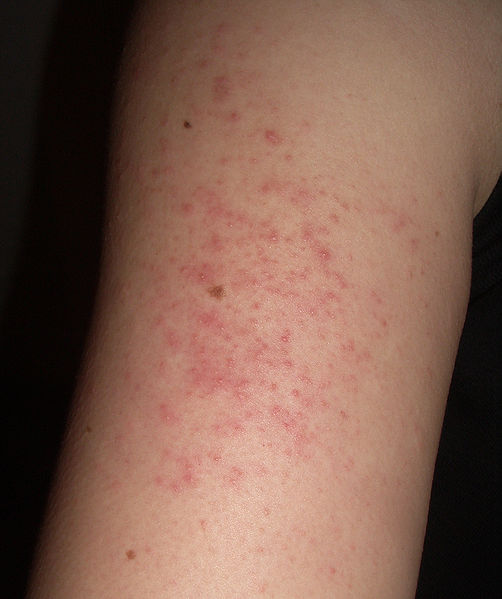Reviewer: S. Randhawa, M.D., Allergist/Immunologist and Assistant Professor at LSU (Shreveport) Department of Allergy and Immunology
A 15-year-old Caucasian female is self-referred to the allergy clinic because of an "allergic rash" for six years affecting the dorsal aspect of both arms, occasionally the back and the legs. She also has history ofdermatographism but does not report any symptoms of asthma, allergic rhinitis, or food allergies. She also reports itching with the rash including during the night and for that, she takeshydroxyzine at night. The rash has been ongoing for six years with waxing and waning episodes throughout the years. The rash present throughout all seasons. She occasionally uses baking soda in the bathtub and she feels that it helps the rash. Skin prick testing was done by another allergist 6 months ago and was positive for cat. The patient saw a dermatologist 2 years ago who did a biopsy, but she does not remember the diagnosis, the biopsy report was "normal."
Past medical history (PMH)
Chronic rash for 6 years.
Medications
Hydroxyzine one tablet po q.h.s. triamcinalone 0.1% cream on the affected areas prn.
Social history
Passive tobacco smoke exposure. Pets: She has two cats and three dogs.
Family history
Father with chronic skin rashes without a clear diagnosis.
Physical examination
Vital signs stable.
Skin: There are erythematous papules the size of 1 to 2 mm, that affect the dorsal aspects of both forearms with the visual effect of sandpaper. There are occasional areas of dry skin and similarerythematous papules on both lower extremities.
Normal nose and throat exam. Respiratory system: Clear to auscultation bilaterally. Cardiovascular system: Clear S1, S2. Abdomen: Soft, non-tender, non-distended. Extremities: no edema.

Keratosis pilaris rubra on the right upper arm. Image source: Wikipedia, Irja, Creative Commons Attribution ShareAlike 2.0 License.
Does she have an allergic condition? What is the most likely diagnosis?
Keratosis pilaris.
What tests would you suggest?
No diagnostic tests are currently indicated. Keratosis pilaris is a clinical diagnosis.
What treatment would you suggest?
Keratosis pilaris is a common genetic condition for which local treatments can be used. A brochure was provided to the patient and she was instructed to use a Lac-Hydrin and other topical treatments available in the brochure. She was advised to use triamcinalone only sparingly for her keratosis pilaris lesions and to follow with a dermatologist for dermal microabrasion in the spring so she can have a cosmetically acceptable appearance to her during the summer months when she wears short sleeves.
What happened?
There is no evidence of any other allergic disease at the moment and therefore we are going to follow up with the patient prn when she needs to see us. She was recommended to follow up with a dermatologist for her keratitis pilaris.
Final diagnosis
Keratosis pilaris
References
Keratosis Pilaris. eMedicine Specialties > Dermatology > Diseases of the Adnexa.
Keratosis pilaris. DermNet NZ.
Patient information
Keratosis pilaris. MayoClinic.com reprints.
Keratosis pilaris. U.S. National Library of Medicine.
Glytone KP Kit is an OTC therapy:
Published: 03/03/2009
Updated: 02/03/2015
2 comments:
What is the medication or medicine for keratosis pilaris
- Lac-Hydrin
- triamcinalone only sparingly
- dermal microabrasion
Post a Comment